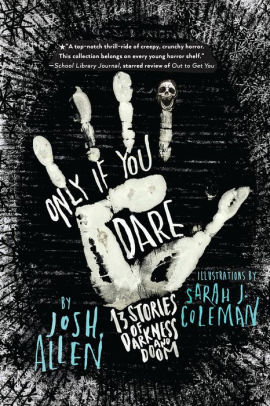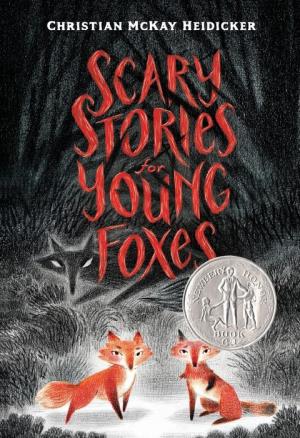What Horror–Yes, Horror–Can Do For Kids, a guest post by Josh Allen

A few days before the recent release of my second middle-grade horror book, Only If You Dare: 13 Stories of Darkness and Doom, I visited my local bookstore to sign the copies they were preparing to shelve.
“We’re going to put them in the children’s horror section,” the cheerful clerk told me. “We didn’t used to have a children’s horror section, but we get asked for so much of it, we had to make one.” She pointed, and there it was.
ADVERTISEMENT
ADVERTISEMENT
A children’s horror section! In my local bookstore! Finally!
But I knew a lot of people would wander past that section and wonder.
Children’s horror? In 2021? Don’t kids get enough of that already in their everyday lives?

Those are fair questions. Obviously, it’s a terrifying time to be to be a kid, and that statement is so apparent I’m not even going to spend a few sentences defending it.
And yet, children’s horror is rising. We see this not only in bookstore shelving practices, but in School Library Journal articles like “Six Late Summer Scares for Tweens” and “17 Books to Get Readers in the Halloween Spirit.” We see it in the success of the recent Fear Street series on Netflix (based on the R. L. Stine books). And we see it in the rising popularity of writers like Christian McKay Heidicker, Katherine Arden, and Jonathan Auxier. And the list goes on.
But . . . why is horror rising? When kids visit libraries and bookstores, why, in these terrifying times, are so many of them seeking out horror? Why not reach instead for some pleasant escapism? A rollicking adventure? A magical voyage? A bit of modern day humor? Wouldn’t those kinds of stories give today’s kids the all-too-welcome distractions they need?
But . . . horror? Really?

I believe the answer to horror’s appeal can be explained, in part, by the words of Natalie Goldberg. Literature, she tells us in the introduction of her book Writing Down the Bones, is for people who are “unconsciously seeking peace, a coming together, an acknowledgement of our happiness or an examination of what is broken, hoping to embrace and bring our suffering to wholeness.”
An examination of what is broken.
Hoping to embrace and bring our suffering to wholeness.
When kids ask for scary books, I believe we’re witnessing exactly what Goldberg describes above—human beings unconsciously reaching out for the stories they know will fill their psychological gaps, for the stories that can help them be made whole.
Let me explain:
In his book The Storytelling Animal, Jonathan Gottschall likens the act of reading fiction to the act of practicing in a flight simulator. The simulator is safe. It’s where you go to hone your skills before dealing with the real situation.

See also: fiction. It’s a flight simulator. “Fiction allows our brains,” Gottschall writes, “to practice reacting to the kinds of challenges that are, and always were, most crucial to our success.”
Like the challenges that come when we’re afraid. Like the challenges that too many kids are facing in 2021.
Sure, escape is nice. Escape from what so many kids have had to endure over the past two years—heartache, confusion, anger, loneliness, crippling loss—would be the sweetest mercy. But sometimes when kids come to the library or to the bookstore, they’re not looking for escape. They’re looking to probe the complex (and sometimes dark) emotions they’ve been carrying around inside them—anxiety, tension, horror. They’re looking for stories that can help them practice dealing with these emotions. They’re looking for a book that can act as a flight simulator, a book that can help then probe the grainy textures of fear and taste the metallic bitterness of it, a book that can teach them how to navigate what it means to be afraid.
A kid reading a scary book is in practice mode, like a movie character in a training montage. Think of Rocky Balboa whacking away at sides of beef. Or Mulan climbing a towering mountain again and again. Or Daniel LaRusso waxing on and waxing off. That’s what kids with spooky books are—fighters looking to level up—and when kids reach for horror, they’re entering the psychic gym, gearing up to do mental calisthenics.
This means that when a kid comes asking for a scary book, we shouldn’t smile politely and substitute in a book we think is more appropriate, maybe one with a bit of charming suspense and a companionable ghost or two.
No. When kids come asking for horror, here’s what we should do:
Give. Them. Horror.
If a kid asks for doom, death, monsters, blood, and worse, we should give that kid doom, death, monsters, blood, and worse. True, there are enough of these things in kids’ day-to-day lives already (sadly), but that is the very point. We can’t shield kids from the blows of this too-terrifying world. All we can do is arm them with the tools they need to navigate it well.
Today’s kids know, deep in their guts, that they need to get good at being afraid. So of course they’re reaching out for stories of darkness and terror.
A side note: None of this means that kids can’t have gobs of fun while also getting scared speechless. They can. And the best horror writers don’t just scare kids. They entertain them. They amaze them. They walk that fine line between horror and humor. (This, by the way, is why the amazing people at Holiday House Books made sure both of my books feature covers that glow in the dark. Spooky, yes. But also, we hope, gobs of fun.)

ADVERTISEMENT
ADVERTISEMENT
We need to trust kids’ unconscious yearnings. We need to trust that they know what kinds of books they need better than we do. We need to trust the healthy cravings of their own psyches.
So, children’s horror? In my local bookstore? In 2021? When there’s already so much horror in kids’ lives?
You bet.
Because kids are smart. If they reach for scary books, they’re doing so for a reason.
They’re choosing terror on the page so they can develop resilience.
They’re choosing stress-filled stories so they can learn to navigate their own anxieties.
They’re choosing fear in fiction so they can cultivate bravery in real life.
May we help them to do all these things and more.
Meet the author

Josh Allen’s debut book, Out to Get You: 13 Tales ff Weirdness And Woe, received starred reviews from School Library Journal and Booklist and was named a Junior Library Guild selection. When his second book, Only If You Dare: 13 Tales of Darkness and Doom, came out School Library Journal wrote, “Allen has cemented himself as the heir-apparent of Alvin Schwartz.” His writing has received praise from The Horn Book, The Wall Street Journal, Kirkus Reviews, and more. Both Out to Get You and Only If You Dare contain artwork by the award-winning illustrator Sarah J. Coleman, and both of these books feature covers that glow in the dark. Josh lives in Idaho with his family where he teaches English.
About Only If You Dare: 13 Stories of Darkness and Doom

Thirteen chilling short stories to keep you up at night—but only if you dare.
You never know what’s out to get you. Though you might think you’re safe from monsters and menaces, everyday objects can turn against you, too. A mysterious microwave. A threatening board game. A snowman that refuses to melt. Even your own heartbeat has its secrets. Thu-thump. Thu-thump. When you stop to listen, each beat sounds more menacing than the last.
Master storyteller Josh Allen brings thirteen nightmare scenarios to life in this page-turning collection that’s perfect for budding horror junkies. In his wondrous world, danger waits behind every doorway . . . even in the most ordinary places.
Eerie illustrations by award-winning artist Sarah Coleman accompany the stories, packaged in a stunning hardcover edition complete with glow-in-the-dark jacket. Readers will sleep with one eye open!
ISBN-13: 9780823449064
Publisher: Holiday House
Publication date: 08/31/2021
Age Range: 9 – 12 Years
Filed under: Uncategorized
About Amanda MacGregor
Amanda MacGregor works in an elementary library, loves dogs, and can be found on Twitter @CiteSomething.
ADVERTISEMENT
ADVERTISEMENT
SLJ Blog Network
2024 Books from Pura Belpré Winners
In Memorium: The Great Étienne Delessert Passes Away
Winnie-The-Pooh | Review
Parsing Religion in Public Schools
ADVERTISEMENT











Great post!